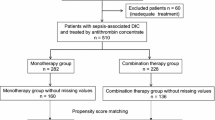Abstract
A randomized prospective double-blind trial was performed to compare the safety and efficacy of human activated protein C (APC) and unfractionated heparin for the treatment of disseminated intravascular coagulation (DIC). One hundred thirty-two patients with DIC were enrolled in this study: 63 patients received APC (12.5 U [2.5 μg]/kg body wt per hour) and 69 patients received heparin (8 U/kg body wt per hour) by intravenous infusion for 6 days. Forty-nine APC-treated patients and 55 heparintreated patients were evaluated for efficacy, and 52 APC-treated patients and 55 heparin-treated patients were evaluated for safety. The 2 groups were similar with respect to sex, age, body weight, underlying diseases, and coagulation/fibrinolysis parameters before treatment. Aggravation of bleeding was seen after treatment in 8 patients receiving heparin, but in none of the patients receiving APC. The number of patients who showed alleviation of bleeding was significantly higher in the APC group than the heparin group (P = .009). The effects on DIC-related organ dysfunction were not significantly different between the 2 groups. Fibrinogen-fibrin degradation products, D-dimer, thrombin-antithrombin complex (TAT), and plasmin-plasmin inhibitor complex (PIC) were all significantly decreased by treatment in both groups. Fibrinogen, protein C, and antithrombin were significantly increased in the APC group, whereas only protein C was significantly increased in the heparin group. Platelet count in the nonleukemic group was significantly increased in those patients receiving APC but not increased in those patients receiving heparin. Improvement of coagulation/ fibrinolysis was assessed by scoring 4 parameters (soluble fibrin monomers, D-dimer, TAT, and PIC), and the results indicated that the APC group showed significantly greater improvement than the heparin group (P = .046). There was, however, no significant difference in the rate of complete recovery from DIC between the 2 groups. The rate of death from any cause within 28 days after treatment was 20.4% in the APC group, significantly lower than the 40% death rate observed in the heparin group (P < .05). There were no severe adverse events in either group. These results suggest that APC in a relatively small dosage can improve DIC more efficiently than can heparin, without increasing bleeding, and may be a better alternative.
Similar content being viewed by others
References
Kisiel W. Human plasma protein C: isolation, characterization, and mechanism of activation by alpha-thrombin.J Clin Invest. 1979;64: 761–769.
Esmon CT. The roles of protein C and thrombomodulin in the regulation of blood coagulation.J Biol Chem. 1989;264:4743–4746.
Comp PC, Esmon CT. Activated protein C inhibits platelet prothrombin-converting activity.Blood. 1979;54:1272–1281.
Branson H, Katz J, Marble R, Griffin JH. Inherited protein C deficiency and coumarin responsive chronic relapsing purpura fulminans in a newborn infant.Lancet. 1983;2:1165–1168.
Marlar RA, Endres-Brooks J, Miller C. Serial studies of protein C and its plasma inhibitor with disseminated intravascular coagulation.Blood. 1985;66:59–63.
Grey S.T, Hau H, Salem HH, Hancock WW. Selective effects of protein C on activation of human monocytes by lipopolysaccharide, interferon-γ, or PMA: modulation of effects on CD11b and CD14 but not CD 25 or CD54 induction.Transplant Proc. 1993;25:2913–2914.
Grey ST, Tsuchida A, Hau H, Orthner CL, Salem HH, Hancock WW. Selective inhibitory effects of the anticoagulant activated protein C on the responses of human mononuclear phagocytes to LPS, IFN-γ, or phorbol ester.J Immunol. 1994;153:3664–3672.
Ryan J, Genczy C. Coagulation and the expression of cell-mediated immunity.Immunol Cell Biol. 1987;65:127–139.
Taylor FB Jr, Chang A, Esmon CT, DAngelo A, Vigano-DAngelo S, Blick KE. Protein C prevents the coagulopathic and lethal effects of Escherichia coli infusion in the baboon.J Clin Invest. 1987;79:918–925.
Okajima K, Imamura H, Koga S, Inoue M, Takatsuki K, Aoki N. Treatment of patients with disseminated intravascular coagulation by protein C.Am J Hematol. 1990;33:277–278.
Bernard GR, Vincent J-L, Leterre P-F, et al. Efficacy and safety of recombinant human activated protein C for severe sepsis.N Engl J Med. 2001;344:699–709.
Kobayashi N, Maekawa T, Takada M, et al. Criteria for diagnosis of DIC based on the analysis of clinical and laboratory findings in 345 DIC patients collected by the Research Committee on DIC in Japan.Bibl Haematol. 1987;49:265–275.
Wada H, Wakita Y, Nakase T, et al. Outcome of disseminated intravascular coagulation in relation to the score when treatment was begun.Thromb Haemost. 1995;74:848–852.
Wada H, Minamikawa K, Wakita Y, et al. Hemostatic molecular markers before the onset of disseminated intravascular coagulation.Am J Hematol. 1999;60:273–278.
Nakahira S, Miyata K, Sugawara K, et al. Characterization of purified protein C derived from human plasma [in Japanese].Iyakuhin Kenkyu. 1994;25:1087–1097.
Takamiya O, Ishida F, Kodaira H, Kitano K. APC-resistance and Mnl I genotype (Gln506) of coagulation factor V are rare in Japanese population.Thromb Haemost. 1995;74:996.
Fujimura H, Kambayashi J, Monden M, Kato H. Coagulation factor V Leiden mutation may have a racial background.Thromb Haemost. 1995;74:1381–1382.
Ro A, Hara M,Takada A.The factor V Leiden mutation and the prothrombin G20210A mutation was not found in Japanese patients with pulmonary thromboembolism.Thromb Haemost. 1999;82:1769.
Aoki N, Takatsuki K, Matsuda T, et al. Studies on the treatment of disseminated intravascular coagulation with activated protein C (CTC-111). Late phase II [in Japanese].Shinyaku To Rinsho. 1998; 47:425–447.
Matsuda T. Therapy of DIC [in Japanese].Igaku No Ayumi. 1997; 109:91–96.
Author information
Authors and Affiliations
Corresponding author
About this article
Cite this article
Aoki, N., Matsuda, T., Saito, H. et al. A Comparative Double-Blind Randomized Trial of Activated Protein C and Unfractionated Heparin in the Treatment of Disseminated Intravascular Coagulation. Int J Hematol 75, 540–547 (2002). https://doi.org/10.1007/BF02982120
Received:
Revised:
Accepted:
Published:
Issue Date:
DOI: https://doi.org/10.1007/BF02982120




